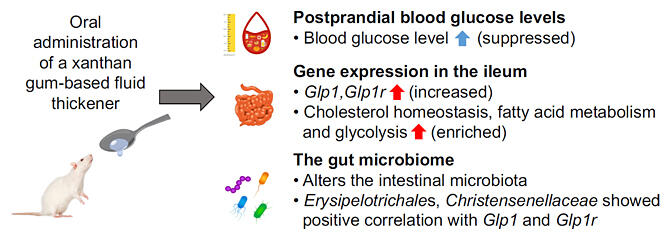A research group led by Sayaka Katagiri, Associate Professor at the Department of Periodontology, Graduate School of Medical and Dental Sciences at Tokyo Medical and Dental University; Haruka Tohara, Professor of Dysphagia Rehabilitation at the Department of Gerontology and Gerodontology; Kazuharu Nakagawa, Associate Professor; and Yuki Nagasawa, a graduate student; in collaboration with Naofumi Uesaka, Professor at the Department of Neurophysiology; and Tomomitsu Hirota, Associate Professor at the Division of Molecular Genetics, Research Center for Medical Sciences at The Jikei University School of Medicine, has found that xanthan gum-based fluid thickener used to prevent aspiration on foods and drinks suppresses blood glucose levels after eating, and that long-term intake changes the expression levels of genes related to glucose and lipid metabolism in the ileum, and composition of gut microbiome.

Provided by TMDU
To date, there had been no studies examining the effects of fluid thickener used to prevent aspiration for the patient with dysphagia, and on the effects of its long-term intake. Xanthan gum-based fluid thickener in saline was fed it to rats for five weeks to evaluate the effects on blood glucose after eating, gene expression in the intestinal tract, and changes in the gut microbiome after long-term intake of the fluid thickener. An oral glucose tolerance test had done to determine the effect on blood glucose levels four weeks after the start of intake. As a result, xanthan gum-based fluid thickener fed to the rats suppressed blood glucose levels.
The gastrointestinal tracts of the stomach, duodenum, jejunum, and ileum were sampled after five weeks, and qPCR had done to analyze the gene expression levels of Glp1 (glucagon-like peptide-1), which is also a target for diabetes treatment and is important in the secretion of insulin. The results showed that consumption of the fluid thickener increased Glp1 gene expression in the ileum. Then, a comprehensive analysis of gene expression and gut microbiome in the ileum has performed by using next-generation sequencing. Twenty-five genes with significantly changed expression level were detected in the ileum, among which the gene expression of Glp1r was elevated in rats fed the xanthan gum-based fluid thickener.
Furthermore, consumption of the xanthan gum-based fluid thickener also altered the gut microbiome, of which Erysipelotrichales and Christensenellaceae, showed a strong positive correlation with the gene expression of Glp1 and Glp1r in the ileum.
"Based on the basic data obtained in our research, we expect to apply this to clinical practice," commented Katagiri. "Moving forward, we will evaluate the effect of the fluid thickener on the suppression of blood glucose and explore new uses for it other than preventing aspiration. At the same time, we would like to build various basic evidence in the field of dysphagia rehabilitation as well as conventional dentistry."
■ qPCR method: A method for amplifying target genes using enzymes and quantifying gene expression.
This article has been translated by JST with permission from The Science News Ltd. (https://sci-news.co.jp/). Unauthorized reproduction of the article and photographs is prohibited.




